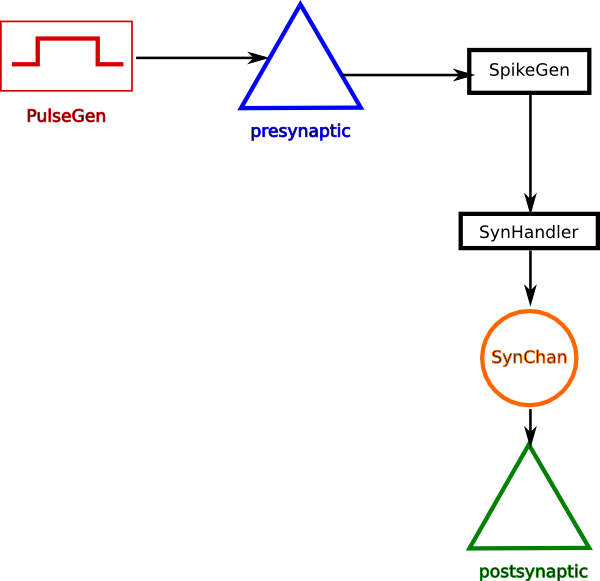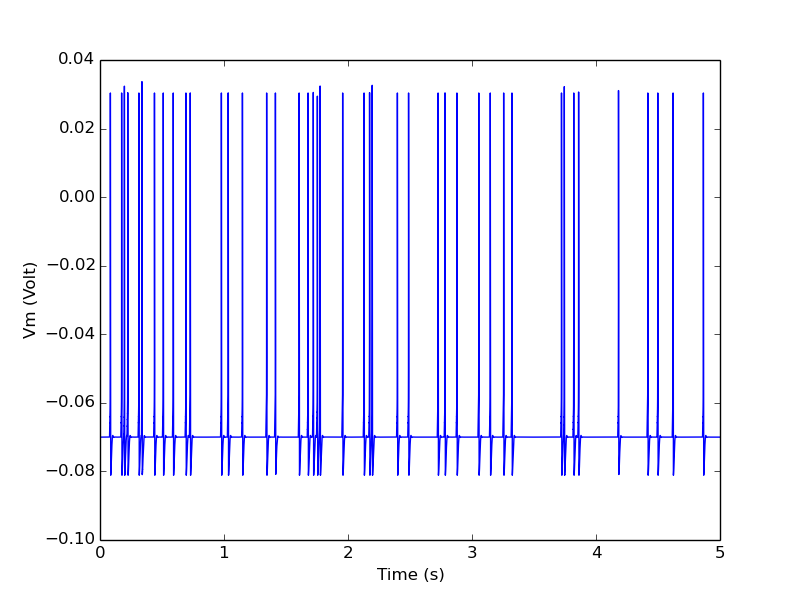Simple Examples¶
How to run these examplesConnecting two cells via a synapse¶
Below is the connectivity diagram for setting up a synaptic connection from one neuron to another. The PulseGen object is there for stimulating the presynaptic cell as part of experimental setup. The cells are defined as single-compartments with Hodgkin-Huxley type Na+ and K+ channels.
-
twocells.create_model()[source]¶ Create two single compartmental neurons, neuron_A is the presynaptic neuron and neuron_B is the postsynaptic neuron.
1. The presynaptic cell's Vm is monitored by a SpikeGen object. Whenever the Vm crosses the threshold of the spikegen, it sends out a spike event message.
2. This is event message is received by a SynHandler, which passes the event as activation parameter to a SynChan object.
3. The SynChan, which is connected to the postsynaptic neuron as a channel, updates its conductance based on the activation parameter.
4. The change in conductance due to a spike may evoke an action potential in the post synaptic neuron.
Multi Compartmental Leaky Neurons¶
-
class
multicomp_lif.LIFComp(*args)[source]¶ Leaky integrate and fire neuron using regular compartments, spikegen and Func.
-
Vreset¶ Reset voltage. The cell's membrane potential is set to this value after spiking.
-
Vthreshold¶ Threshold voltage. The cell spikes if its membrane potential goes above this value.
-
-
multicomp_lif.main()[source]¶ This is an example of how you can create a Leaky Integrate and Fire compartment using regular compartment and Func to check for thresold crossing and resetting the Vm.
-
multicomp_lif.setup_two_cells()[source]¶ Create two cells with leaky integrate and fire compartments. The first cell is composed of two compartments a1 and a2 and the second cell is composed of compartments b1 and b2. Each pair is connected via raxial message so that the voltage of one compartment influences the other through axial resistance Ra.
The compartment a1 of the first neuron is connected to the compartment b2 of the second neuron through a synaptic channel.
Providing random input to a cell¶
-
randomspike.create_cell()[source]¶ Create a single-compartment Hodgking-Huxley neuron with a synaptic channel.
This uses the
ionchannel.create_1comp_neuron()function for model creation.Returns a dict containing the neuron, the synchan and the synhandler for accessing the synapse,
-
randomspike.example()[source]¶ The RandSpike class generates spike events from a Poisson process and sends out a trigger via its spikeOut message. It is very common to approximate the spiking in many neurons as a Poisson process, i.e., the probability of k spikes in any interval t is given by the Poisson distribution:
exp(-ut)(ut)^k/k!for k = 0, 1, 2, ... u is the rate of spiking (the mean of the Poisson distribution). See wikipedia for details.
Many cortical neuron types spontaneously fire action potentials. These are called ectopic spikes. In this example we simulate this with a RandSpike object with rate 10 spikes/s and send this to a single compartmental neuron via a synapse.
In this model the synaptic conductance is set so high that each incoming spike evokes an action potential.
Plastic synapse¶
-
STDP.main()[source]¶ Connect two cells via a plastic synapse (STDPSynHandler). Induce spikes spearated by varying intervals, in the pre and post synaptic cells. Plot the synaptic weight change for different intervals between the spike-pairs. This ia a pseudo-STDP protocol and we get the STDP rule.
On the command-line, in moose-examples/snippets directory, run
python STDP.py
-
STDP.make_neuron_spike(nrnidx, I=1e-07, duration=0.001)[source]¶ Inject a brief current pulse to make a neuron spike
Synapse Handler for Spikes¶
-
RandSpikeStats.main()[source]¶ This snippet shows the use of several objects. This snippet sets up a StimulusTable to control a RandSpike which sends its outputs to two places:
to a SimpleSynHandler on an IntFire, which is used to monitor spike arrival, and to various Stats objects.
I record and plot each of these. The StimulusTable has a sine-wave waveform
Recurrent integrate-and-fire network¶
-
recurrentIntFire.make_network()[source]¶ This snippet sets up a recurrent network of IntFire objects, using SimpleSynHandlers to deal with spiking events. It isn't very satisfactory as activity runs down after a while. It is a good example for using the IntFire, setting up random connectivity, and using SynHandlers.
Recurrent integrate-and-fire network with plasticity¶
-
recurrentLIF.make_network()[source]¶ This snippet sets up a recurrent network of LIF objects, using SimpleSynHandlers to deal with spiking events. It isn't very satisfactory as activity runs down after a while. It is a good example for using the LIF, setting up random connectivity, and using SynHandlers.
Demonstration Models¶
-
compartment_net.create_network(size=2)[source]¶ Create a network containing two neuronal populations, pop_A and pop_B and connect them up.
-
compartment_net.create_population(container, size)[source]¶ Create a population of size single compartmental neurons with Na+ and K+ channels. Also create SpikeGen objects and SynChan objects connected to these which can act as plug points for setting up synapses later.
This uses ionchannel.create_1comp_neuron.
-
compartment_net.main()[source]¶ This example illustrates how to create a network of single compartmental neurons connected via alpha synapses. It also shows the use of SynChan class to create a network of single-compartment neurons connected by synapse.
-
compartment_net.make_synapses(spikegen, synhandler, connprob=1.0, delay=0.005)[source]¶ - Create synapses from spikegen array to synchan array.
- spikegen: vec of SpikGen elements
- Spike generators from neurons.
- synhandler: vec of SynHandler elements
- Handles presynaptic spike event inputs to synchans.
- connprob: float in range (0, 1]
- connection probability between any two neurons
- delay: float (mean delay of synaptic transmission)
- Individual delays are normally distributed with sd=0.1*mean.
Following, is a demo to create a network of single compartmental neurons connected via alpha synapses. This is same as compartment_net.py except that we avoid ematrix and use single melements.
-
compartment_net_no_array.assign_clocks(model_container_list, simdt, plotdt)[source]¶ Assign clocks to elements under the listed paths.
This should be called only after all model components have been created. Anything created after this will not be scheduled.
-
compartment_net_no_array.create_population(container, size)[source]¶ Create a population of size single compartmental neurons with Na and K channels. Also create SpikeGen objects and SynChan objects connected to these which can act as plug points for setting up synapses later.
-
compartment_net_no_array.main()[source]¶ A demo to create a network of single compartmental neurons connected via alpha synapses. This is same as compartment_net.py except that we avoid ematrix and use single melements.
-
compartment_net_no_array.make_synapses(spikegen, synchan, delay=0.005)[source]¶ - Create synapses from spikegens to synchans in a manner similar to OneToAll connection.
- spikegen: list of spikegen objects
- These are sources of synaptic event messages.
- synchan: list of synchan objects
- These are the targets of the synaptic event messages.
- delay: mean delay of synaptic transmission.
- Individual delays are normally distributed with sd=0.1*mean.
Building Models¶
-
synapse_tutorial.main()[source]¶ In this example we walk through creation of a vector of IntFire elements and setting up synaptic connection between them. Synapse on IntFire elements is an example of ElementField - elements that do not exist on their own, but only as part of another element. This example also illustrates various operations on vec objects and ElementFields.

